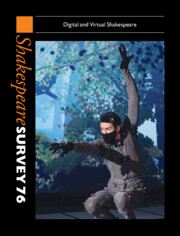Book contents
- Shakespeare Survey 76
- Shakespeare Survey
- Shakespeare Survey
- Copyright page
- Editor’s Note
- Contributors
- Contents
- Illustrations
- All Early Modern Drama Is Virtual to Us
- RSC Live from Stratford-upon-Avon: Ten Things I Think I Know, or, Of Course We’re Making a Movie
- Digital Ariel: An Interview with Mark Quartley
- Staging Digital Co-Presence: Punchdrunk’s Hybrid Sleep No More (2012) And Pandemic-Informed Pedagogies
- ‘Very Tragical Mirth’: Performing A Midsummer Night’s Dream on Screen(s) during Lockdown
- ‘Uneasy Lies the Head’: Michael Almereyda’s Halloween Cymbeline
- When Is King Lear Not King Lear?
- Sim-Ulating Shakespeare: From Stage to Computer Screen
- Metre in the Middle Distance
- ‘What’s in a “Quire”?’ Vicissitudes of the Virtual in Shakespeare’s Julius Caesar and Romeo and Juliet
- ‘And Which the Jew?’: Representations Of Shylock in Meiji Japan (1868–1912)
- Hamlet, Translation and the Linguistic Conditions of Thought
- The Pietas Of Dogberry
- Taylor Mac’s Gary and Queer Failure in Titus Andronicus
- ‘I Would Cure You’: Self-Help Advice on Love in Sidney and Shakespeare
- Shakespeare in Arden: Pragmatic Markers and Parallels
- Sycorax’s Hoop
- Shakespeare Performances in England, 2022
- Peter Kirwan, Productions Outside London
- Professional Shakespeare Productions in the British Isles, January–December 2021
- The Year’s Contribution to Shakespeare Studies
- Abstracts of Articles in Shakespeare Survey 76
- Index
Metre in the Middle Distance
Published online by Cambridge University Press: 17 August 2023
- Shakespeare Survey 76
- Shakespeare Survey
- Shakespeare Survey
- Copyright page
- Editor’s Note
- Contributors
- Contents
- Illustrations
- All Early Modern Drama Is Virtual to Us
- RSC Live from Stratford-upon-Avon: Ten Things I Think I Know, or, Of Course We’re Making a Movie
- Digital Ariel: An Interview with Mark Quartley
- Staging Digital Co-Presence: Punchdrunk’s Hybrid Sleep No More (2012) And Pandemic-Informed Pedagogies
- ‘Very Tragical Mirth’: Performing A Midsummer Night’s Dream on Screen(s) during Lockdown
- ‘Uneasy Lies the Head’: Michael Almereyda’s Halloween Cymbeline
- When Is King Lear Not King Lear?
- Sim-Ulating Shakespeare: From Stage to Computer Screen
- Metre in the Middle Distance
- ‘What’s in a “Quire”?’ Vicissitudes of the Virtual in Shakespeare’s Julius Caesar and Romeo and Juliet
- ‘And Which the Jew?’: Representations Of Shylock in Meiji Japan (1868–1912)
- Hamlet, Translation and the Linguistic Conditions of Thought
- The Pietas Of Dogberry
- Taylor Mac’s Gary and Queer Failure in Titus Andronicus
- ‘I Would Cure You’: Self-Help Advice on Love in Sidney and Shakespeare
- Shakespeare in Arden: Pragmatic Markers and Parallels
- Sycorax’s Hoop
- Shakespeare Performances in England, 2022
- Peter Kirwan, Productions Outside London
- Professional Shakespeare Productions in the British Isles, January–December 2021
- The Year’s Contribution to Shakespeare Studies
- Abstracts of Articles in Shakespeare Survey 76
- Index
Summary
Let us begin with a delicious pedagogical observation by Andrew DuBois. ‘Still today’, he writes, ‘with the supposed decline of New Criticism as institutional practice, it is not uncommon at even the highest levels of undergraduate education that students be asked to “do a close reading”, if only as a sort of hors d’oeuvre to the final extratextual platter.’2 The phrase ‘do a close reading’ indicates that critical closeness is as much a matter of the critic’s writing as of their reading – hence the ‘close’ style of some critical prose, with ‘closeness’ here existing in the atmospheric or meteorological sense of being dense or humid. Although the range of practices commonly referred to under the rubric of ‘close reading’ – the family resemblances, if you will, of American New Criticism and English practical criticism – are recognizable enough, what, I wonder, would constitute metrical close reading?
- Type
- Chapter
- Information
- Shakespeare Survey 76Digital and Virtual Shakespeare, pp. 85 - 92Publisher: Cambridge University PressPrint publication year: 2023

